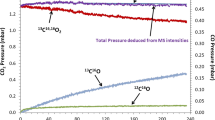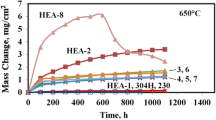Abstract
When steels oxidize in CO2-based atmospheres, they frequently experience an enhanced form of attack known as “breakaway.” It has been suggested that for this to occur, the gas in contact with the metal must be not only oxidizing but also carburizing with respect to iron. This approach implies that as part of the breakaway process either carbon will be deposited in the oxide (a feature commonly observed with some mild steels) or carbides will form. The present work has tested this hypothesis by analyzing the thermodynamics of chemical equilibria between the individual gases in an AGR atmosphere and iron using techniques developed by other workers. The results have been used to predict the oxidizing and carburizing tendencies of various gas mixtures and thus to identify those conditions which are capable of supporting the breakaway process. This theoretical approach has been compared with experimental observations and found to show significant agreement.
Similar content being viewed by others
References
A. M. Pritchard, J. E. Antill, K. R. J. Cottell, K. A. Peakall, and A. E. Truswell,Proceedings of the BNES International Conference on Corrosion of Steels in CO 2, Reading, (1974), Paper 7.
D. Goodison, In Discussion,Proceedings of the BNES International Conference on Corrosion of Steels in CO 2, Reading, (1974), p. 147.
P. L. Surman and J. E. Castle,Corros. Sci. 9, 771 (1969).
D. B. Meadowcroft and C. Doyle, paper presented at 16th Corrosion Science Symposium, Swansea (Sept. 1975).
C. Moore and T. Raine, “Steels for Reactor Circuits,” ISI Special Report No. 69, (1961) p. 136.
G. D. Renshaw, C. Roscoe, and P. L. Walker,J. Catalysis 18, 164 (1970).
E. D. Hyam and S. TimperleyBr. Corros. J. 4, 260 (1969).
S. Timperley, “A User's Guide to Carbox,” UKAEA TRG Report 1567 (W), (1969).
R. W. Gurry,Trans. Amer. Inst. Mech. Eng. 188, 671 (1950).
J. Hilsenrathet al., Tables of Thermodynamic and Transport Properties of Air, A, CO 2,CO, H 2,N 2,O 2 and Steam, (Pergamon, Oxford, 1960).
P. L. Surman,Corros. Sci. 13, 825 (1973).
J. M. Ferguson, J. C. P. Garrett, and B. Lloyd,Proceedings of the BNES International Conference on Corrosion of Steels in CO 2, Reading, (1974), Paper 2.
P. A. German and A. C. Littlejohn,Proceedings of the BNES International Conference on Corrosion of Steels in CO 2, Reading, (1974), Paper 1.
M. F. Taylor, to be published.
Author information
Authors and Affiliations
Rights and permissions
About this article
Cite this article
Taylor, M.F. The application of thermodynamics to the oxidation behavior of mild steels in carbon dioxide-based atmospheres. Oxid Met 16, 133–146 (1981). https://doi.org/10.1007/BF00603748
Received:
Issue Date:
DOI: https://doi.org/10.1007/BF00603748




